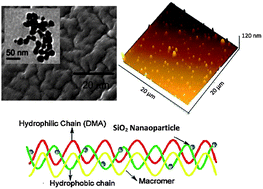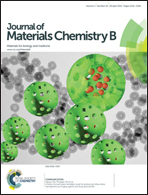Nanocomposited silicone hydrogels with a laser-assisted surface modification for inhibiting the growth of bacterial biofilm
Abstract
Surface and interface modifications of synthetic silicone hydrogels used for wearable and implantable medical devices, e.g. catheters and contact lenses, are critical to overcome their poor mechanical properties and biofouling. In this paper, silica nanoparticles (SiO2 NPs) were incorporated within silicone hydrogels through photo-polymerization. As compared to the silicone hydrogel, the nanocomposited silicone hydrogel shows highly textured microstructures, increased swelling behaviour and improved stiffness. Meanwhile, a hydrophilic surface of silicone hydrogel is important to minimize protein fouling which forms a conditioning layer for the growth of bacterial biofilm. Here, we applied matrix-assisted pulsed laser evaporation (MAPLE) with a pulsed Nd:YAG laser at 532 nm to deposit polyethylene glycol (PEG) on the surface of the nanocomposited silicone hydrogels. The PEG deposited on the nanocomposited silicone hydrogels forms islands at the submicron-scale, which increase with increasing irradiation time (t). The protein adsorption on nanocomposited silicone hydrogel with PEG deposition decreases over 40 ± 2% when t = 2 h. Compared to the commercial silicone catheters, the nanocomposited silicone hydrogel with PEG deposition can reduce the growth of bacteria from 1.20 × 106 CFU cm−2 to 3.69 × 105 CFU cm−2. In addition, the relative cell viabilities of NIH/3T3 mouse fibroblast cells treated using the nanocomposited silicone hydrogels coated with/without PEG were studied. No toxic effect is imposed on the cells. Consequently, the MAPLE process is a controllable, contamination-free technique to modify the surface of silicone hydrogels. We expect that the nanocomposited silicone hydrogels with appropriate surface treatment can be applied in various wearable and implantable medical devices.


 Please wait while we load your content...
Please wait while we load your content...